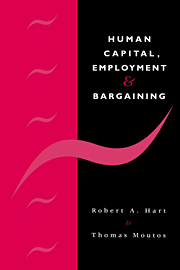Book contents
- Frontmatter
- Contents
- Preface
- 1 Overview
- 2 Labour demand and efficient contract models
- 3 Turnover costs, firm-specific training and unemployment
- 4 Employment and bargaining
- 5 Choice of compensation, unemployment insurance and policy issues
- 6 Team-related human capital and bargaining
- 7 Coalitional versus neoclassical firms
- 8 Future developments
- Bibliography
- Index
7 - Coalitional versus neoclassical firms
Published online by Cambridge University Press: 05 November 2011
- Frontmatter
- Contents
- Preface
- 1 Overview
- 2 Labour demand and efficient contract models
- 3 Turnover costs, firm-specific training and unemployment
- 4 Employment and bargaining
- 5 Choice of compensation, unemployment insurance and policy issues
- 6 Team-related human capital and bargaining
- 7 Coalitional versus neoclassical firms
- 8 Future developments
- Bibliography
- Index
Summary
Organisational capital and the coalitional firm
In chapter 2 (section 2.1), we introduced the notion of quasi-rents resulting from investments by the firm in the human capital of its workforce. Investment decisions are made by the firm on behalf of (or through bargaining with) each new recruit. Firm-specific human capital in this context relates to investment by the firm in an individual's off- or on-the-job training that enhances ‘internal’ marginal product while leaving opportunity marginal product unaltered. In general, it pays the parties to share the rent stemming from specific investment. The lower the transaction costs of verifying and agreeing to information on workers' productivity, the greater the expected value to both parties of sharing the costs and returns to investment. The notions of rent creation and sharing are extended in chapter 6 in order to encompass human capital investments with respect to a group of workers. Such investment is likely to be particularly apparent in large firms where standardised production methods require a complete team of workers to be familiar with carefully prescribed work routines and organisational procedures. In turn, this introduces the idea of human capital investment decisions being undertaken at workforce- rather than individual-level bargaining. Enterprise-specific unionisation bolsters the process whereby the firm and the workforce agree to such collectivised investment decision making. Investments in a set of skills and know-how enjoyed by a team of workers are likely to enhance informational efficiency and reduce monitoring costs.
- Type
- Chapter
- Information
- Human Capital, Employment and Bargaining , pp. 163 - 183Publisher: Cambridge University PressPrint publication year: 1995



